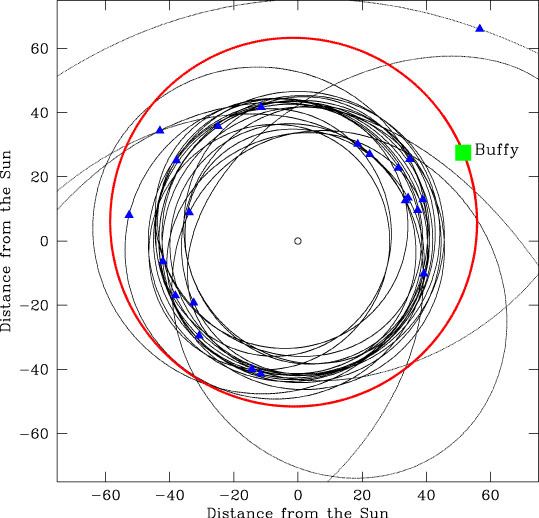Discovery date 11 December 2004 Alternative names none | MPC designation 2004 XR190 Observation arc 2957 days (8.10 yr) | |
 | ||
Discovered by Lynne Jones
Brett Gladman
John J. Kavelaars
Jean-Marc Petit
Joel Parker
Phil Nicholson Minor planet category cubewano
detached object | ||
2004 XR190 is a possible dwarf planet located in the scattered disc. It has a highly inclined low-eccentricity orbit. It was discovered in December 2004.
Contents
Discovery
2004 XR190 was discovered on 11 December 2004. It was discovered by astronomers led by Lynne Jones of the University of British Columbia as part of the Canada–France Ecliptic Plane Survey (CFEPS) using the Canada–France–Hawaii Telescope (CFHT) near the ecliptic. In 2015, six precovery images from 2002 and 2003 were found in Sloan Digital Sky Survey data.
Naming
The discovery team nicknamed 2004 XR190 "Buffy", after the fictional vampire slayer, and proposed several Inuit-based official names to the IAU.
Orbit
Considered a detached object, 2004 XR190 is particularly unusual for two reasons. With an inclination of 47 degrees, it is the largest possible dwarf planet that has an inclination larger than 45 degrees, traveling further "up and down" than "left to right" around the Sun when viewed edge-on along the ecliptic. Second, it has an unusually circular orbit for a scattered-disc object (SDO). Although it is thought that traditional scattered-disc objects have been ejected into their current orbits by gravitational interactions with Neptune, the low eccentricity of its orbit and the distance of its perihelion (SDOs generally have highly eccentric orbits and perihelia less than 38 AU) seems hard to reconcile with such celestial mechanics. This has led to some uncertainty as to the current theoretical understanding of the outer Solar System. The theories include close stellar passages, rogue planets/planetary embryos in the early Kuiper belt, and resonance interaction with an outward-migrating Neptune. The Kozai mechanism is capable of transferring orbital eccentricity to a higher inclination.
2004 XR190 came to aphelion around 1901. Other than long-period comets, it is currently about the thirteenth-most-distant known large body (57.5 AU) in the Solar System with a well-known orbit, after Eris and Dysnomia (96.3 AU), 2007 OR10 (87.4 AU), Sedna (85.9 AU), 2014 FC69 (84.0 AU), 2006 QH181 (83.3 AU), 2012 VP113 (83.3 AU), 2013 FY27 (80.3 AU), 2010 GB174 (70.5 AU), 2000 CR105 (60.3 AU), 2003 QX113 (59.8 AU), and 2008 ST291 (59.6 AU).
Size
2004 XR190 has a diameter estimated at around 500 kilometres (310 mi), roughly a quarter the size of Pluto, and it orbits between 51 and 64 AU (7.7 and 9.5 billion kilometers) from the Sun.
